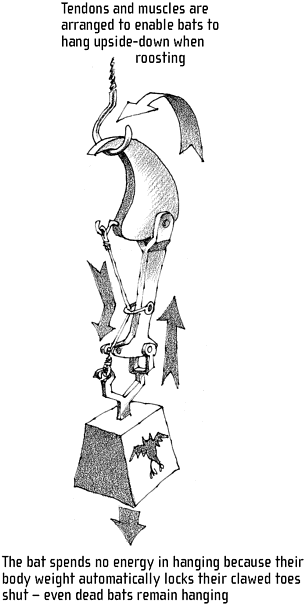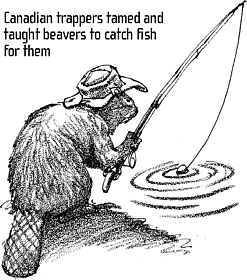The Book of Animal Ignorance (4 page)
Read The Book of Animal Ignorance Online
Authors: Ted Dewan

T
here are a lot of bats. They account for a fifth of all mammal species and are more widely distributed, and come in a wider range of shapes and sizes, than any other mammalian order except the rodents.
Their success isn't hard to understand. They are the only mammal so far to sprout wings and fly, opening up a whole new world of habitats and food sources. Their order name
Chiroptera
means âhand wing', and their wings remain recognisable as hands, with a thumb and four fingers. If ours grew to match them, our fingers would be almost 7 feet long and thinner than knitting needles.

The 900 species of bat are split into two families: the micros and the megas. The megas are the tropical fruit bats; the much more numerous micros are the echolocators. An average microbat emits 400,000 calls an evening. These âchirps' have been measured at 110 decibels: louder than the average rock band, but at a frequency too high for us to hear. Bats prevent damage to their own ears by closing them with every wing stroke. They also use the energy from the stroke to force the air through their larynx, so flaps, chirps and ear muffling are perfectly coordinated.
Each chirp of sound can tell the bat the location, size, direction and even the
hardness of an object. It is accurate enough to detect a single thread of spider silk 3 feet away. Once locked on to prey the ultrasound speeds up into attack mode.
The largest-ever gatherings of âhappiness'. mammals are the fifty-million-strong roosts of the Mexican free-tailed bat (
Tadarida brasiliensis mexicana
) whose âevening;' evacuation has to start in the mid-afternoon to allow them all time to exit.
Inside the ânursing' roosts, there are more than 1,500 babies per square foot, yet the mother bats use sound and smell to feed only their own offspring. The females âconceive' while hibernating, warming up in their sleep as the wandering males caress them. The sperm stays alive inside the female until they wake in the spring and the eggs are finally fertilized
Bats groom themselves for an hour a day, rubbing their wings with oil from glands on their faces, to keep them moist and supple. They can live for thirty years.
Vampire bats (
Desmodus rotundus
) feed mainly on cattle, horses, tapirs and turkeys. If they do dine on humans, they usually go for the big toe, not the neck, but can only manage two tablespoons at one sitting. They are the only mammals to live exclusively on blood. It is a relatively low-energy food, so if a vampire fails to score over two consecutive nights it will die. To offset this, they have developed a sophisticated system in which adult females feed one another. They even remember who has helped them and make sure they get repaid first. A blood-thinning drug developed from vampire bat saliva, called
draculin
, is used to treat heart attack and stroke victims.
To the Chinese, bats are lucky: the word âfu' means both âbat' and âhappiness'
.

Bat guano is valuable as fertiliser and is a source of saltpetre used to make gunpowder. It is also nutritious: a quarter-pound of it contains more protein and minerals than a Big Mac.
M
ale and female bears are known as
boars
and
sows
, despite being about as closely related to pigs as koalas are to bears, or pandas to cats. The bear family's closest relatives are actually dogs, but one thing they do share with pigs is an omnivorous diet â most are as happy snacking on plants and fruit as they are gnawing on the leg of an elk. They can be fussy, too. Only a really hungry brown bear (
Ursus arctos
) eats a whole salmon. Most of the time it only goes for the high-nutrition bits: the brain, skin and eggs. And even the exclusively carnivorous polar bear (
Ursus maritimus
) has an odd liking for toothpaste. They have been known to raid Arctic tourist camps, knocking over tents and trampling equipment just to suck a tube of Colgate dry.
Bears spend much of their days eating, laying down fat reserves to get through the seven months they spend sleeping. Technically this isn't hibernation but âtorpor' because their body temperature, respiration and metabolic rate hardly alter. During this whole time they don't eat, drink, urinate or defecate but recycle their urea into protein and plug their anuses with a mixture of faeces, hair and bedding material called a âtappet'. Female bears even give birth in their sleep: the cubs are tiny and premature and weigh a tenth of those of similar-sized mammals. As a result bear's milk is much richer than that of other carnivores and the cubs grow quickly. Newborn brown bears hum loudly while nursing, to help stimulate their mother's milk production. Each cub in a litter is quite likely to have a different father. Unsurprisingly, female bears have little or no post-coital contact with their partners.
Bears can sleep for as long as a month in the same position if not disturbed. All other mammals, including humans, suffer from osteoporosis (a thinning and weakening of bone) if they maintain non-weight-bearing positions for a long time, but bears recycle
calcium into their bones and wake up just as strong as when they nodded off.
Polar bears aren't
white. Their skin is
black, and their fur
is translucent â
their apparent
whiteness is the
result of light being
refracted from the
clear strands
.
If someone offers you a slice of polar bear's liver, don't be tempted. A pound contains enough vitamin A to kill you. A smaller dose will merely lead to headaches, blurred vision, loss of hair, drowsiness, diarrhoea and enlargement of the spleen and liver.
The government of Yukon, as part of its official advice on what to do when you meet a bear, says that it âcan be dangerous to crowd a bear's personal space' â a statement which has about it the ring of truth. Brown bears can be black and black bears can be brown. Unfortunately, it's important to know the difference: if confronted by a brown bear, you should play dead. If you do that to a carrion-loving black bear (
Ursus americanus
), it will start to eat you. Not that you are in any serious danger. In the US, you are twenty-five times more likely to be killed by a snake, 180 times more likely to die from a bee-sting and 90,000 times more likely to be shot, stabbed or beaten to death by a fellow human, than to die at the paws of a bear.
FRUIT AND NUT CASE

B
eavers have a greater impact on their surroundings than any creature other than humans. They build instinctively: put a young beaver in a cage and even without trees or running water, it still mimes the process of building a dam. They can chop down a tree with a 6-inch diameter in less than an hour. Some scientists now think the disappearance of the Pennine forests and the creation of the Fens were due to the beavers that lived in Britain until the early thirteenth century (the town of Beverly in Yorkshire is named after them).
Beavers are rodents, like large squirrels. There are only two species: the Eurasian (
Castor fiber
) and the North American (
Castor
canadensis
). Although similar in size and appearance the two have been separated for 24,000 years, so can no longer interbreed. They are larger than you might think. A fully grown beaver is the size of an eight-year-old human. The Giant beaver (
Castor
ohioensis
), which became extinct 10,000 years ago, was the size of Mike Tyson.
Beavers can stay submerged for up to fifteen minutes. They have webbed hind feet, a flat tail to steer, transparent eyelids that work as goggles, fur-lined waterproof lips and closable ear and nostril openings to enable them to gnaw under water. The beaver's four incisors are bright orange. The enamel contains iron, for extra strength, and they never stop growing.
Canada is built
on dead beavers.
MARGARET ATWOOD
Despite their âbusy' reputation, beavers can be rather lazy. During winter the average beaver only leaves its lodge once every two weeks. In spring and autumn the beaver's tail doubles in size. Beavers store their energy in their tails, so the tail shrinks as the fat is used up throughout winter.
In 1760, the College of Physicians and Faculty of Divinity in Paris classified the beaver as a fish because of its scaly tail. This
meant that French settlers in North America could officially eat beaver during Lent and on other fast days. Beaver tail is supposed to taste like roast beef.

Beavers were once seen as walking medicine cabinets. The secretion of two glands near their bladder was known as
castoreum
and, from the ancient Greeks onwards, it was used as a fail-safe remedy for headaches, fevers, epilepsy and as a purgative. The Sami, in Lapland, mixed it with snuff. It is now only used in perfume. Shalimar by Guerlain and Magie Noire by Lancôme both contain synthetic beaver juice.
Unfortunately, the high value of castoreum and the fact that it sounds like âcastrate' seemed to encouraged belief in the myth, propagated by Aesop and Pliny the Elder among others, that a hunted beaver gnaws off its own testicles to escape.

It doesn't, but beavers were hunted nonetheless: in seventeenth-century Canada their pelts became a currency called a âmade-beaver' or âM-B'. A gun was worth 132 M-Bs. At the same time in Britain, âbeaver' came to mean âhat'. In 1628 Charles I declared ânothing but beaver stuff or beaver wool shall be used in the making of hats'. Beaver hats weren't furry: their hair was ground, squeezed and heated to make water-resistant felt.



